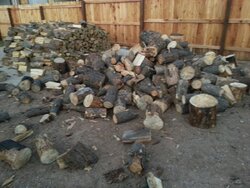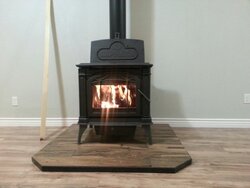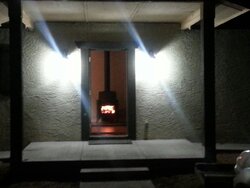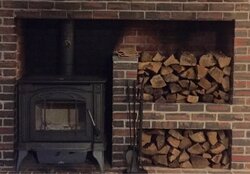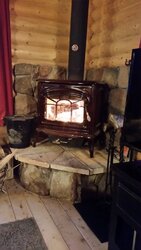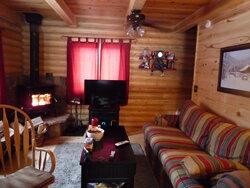New member here but I've been reading and learning from the forum for a few weeks.
We just had our 1400C installed earlier this week.
The manual suggested a few small fires to dry out any moisture in the firebrick and to cure the paint. Took it to 400 degrees with the first fire on Tues night and 600 with the second on Weds night.
First fire was a handful of splitting trash for kindling, 3 pieces of 2x6 about 4 inches long each, and 1, 4 inch Ponderosa Pine split cut from a down/dead tree (slightly punky and fairly light so assuming quite dry). The manual actually used 2x4 cutoffs as a suggested size of wood for the break-in fires. I left the draft completely open the whole time. This was the 400 degree fire.
Second fire was another handful of splitting trash for kindling, and 3, 4 inch Ponderosa Pine splits (same condition as above). With 1, 6 inch split of very dry aspen. The aspen was dry enough/punky enough to remind me of balsa. Again, I left the draft open the whole time. This was the 600 degree fire.
Tonight my wife was cold (menstrually induced chill) and actually requested a fire (major victory since she has kind of been dragging her feet all along about the stove). So I loaded it up pretty full for the first time, everything the same as above, but used enough of the 4-6 inch Ponderosa splits to fill the fire-box about 3/4 full (firebox is 2.25 ft squared on this stove). The temp on this fire went to 700 degrees and was in the "Too Hot" area of the thermometer. The stove seemed to operate quite well with the first full load and the inside temp of the house went from 67 to 75 within 1.5hrs. Once the fire was going well (secondary gases and all that) I did have to throttle it down with the draft adjust to nearly closed. Once the draft was mostly closed, the fire maintained that 700 degree reading for maybe 2 hours and then started to decrease. I needed to get to work (working nights right now), so I added 2 of the really dry 6 inch balsa-like aspen splits on an extremely hot bed of coals when the stove temp was around 450. It shot right back up to 700 and stayed there (she was texting me thermometer readings after I left) for another 2 hours and then started to decline.
All of the temps were measured with a Condar Inferno magnetic stove top thermometer. The thermometer was placed on the actual sheet metal stove top under the flip up cast iron decorative surround. From looking at the stove itself and the schematics in the manual, I am placing the thermometer right above where the secondary combustion gases are released, slightly left of center-line of stove.
I was never afraid of a run-away fire because the draft control really seems to have good control over the stove. The draft has five graduations with 5 being most open and 0 being most closed. If I close it down to zero, the slow lazy flames instantly disappear and I just have glowing coals. The draft control was at 1 for the 700 degree fire described above.
I'm thinking of trying to verify the thermometers readings by placing it in the oven. The stove manual says it operates best at temps between 250-450. According to the thermometer, I am well above that temp.
My conclusion from these first few fires is that if I load the stove up, I get operating temps of 700 degrees. Is that okay? Is the thermometer just slightly off? Could my wood be too dry? No, I do not have a moisture meter. I do however, live in Northern Arizona and for most of the year humidity levels are in the teens. My wood was harvested from very dead and very dry wood and now sits in full sun with the broad side of the stack facing the prevailing southwesterly winds.
(Sorry for the length).
Thank you in advance for any advice provided.
We just had our 1400C installed earlier this week.
The manual suggested a few small fires to dry out any moisture in the firebrick and to cure the paint. Took it to 400 degrees with the first fire on Tues night and 600 with the second on Weds night.
First fire was a handful of splitting trash for kindling, 3 pieces of 2x6 about 4 inches long each, and 1, 4 inch Ponderosa Pine split cut from a down/dead tree (slightly punky and fairly light so assuming quite dry). The manual actually used 2x4 cutoffs as a suggested size of wood for the break-in fires. I left the draft completely open the whole time. This was the 400 degree fire.
Second fire was another handful of splitting trash for kindling, and 3, 4 inch Ponderosa Pine splits (same condition as above). With 1, 6 inch split of very dry aspen. The aspen was dry enough/punky enough to remind me of balsa. Again, I left the draft open the whole time. This was the 600 degree fire.
Tonight my wife was cold (menstrually induced chill) and actually requested a fire (major victory since she has kind of been dragging her feet all along about the stove). So I loaded it up pretty full for the first time, everything the same as above, but used enough of the 4-6 inch Ponderosa splits to fill the fire-box about 3/4 full (firebox is 2.25 ft squared on this stove). The temp on this fire went to 700 degrees and was in the "Too Hot" area of the thermometer. The stove seemed to operate quite well with the first full load and the inside temp of the house went from 67 to 75 within 1.5hrs. Once the fire was going well (secondary gases and all that) I did have to throttle it down with the draft adjust to nearly closed. Once the draft was mostly closed, the fire maintained that 700 degree reading for maybe 2 hours and then started to decrease. I needed to get to work (working nights right now), so I added 2 of the really dry 6 inch balsa-like aspen splits on an extremely hot bed of coals when the stove temp was around 450. It shot right back up to 700 and stayed there (she was texting me thermometer readings after I left) for another 2 hours and then started to decline.
All of the temps were measured with a Condar Inferno magnetic stove top thermometer. The thermometer was placed on the actual sheet metal stove top under the flip up cast iron decorative surround. From looking at the stove itself and the schematics in the manual, I am placing the thermometer right above where the secondary combustion gases are released, slightly left of center-line of stove.
I was never afraid of a run-away fire because the draft control really seems to have good control over the stove. The draft has five graduations with 5 being most open and 0 being most closed. If I close it down to zero, the slow lazy flames instantly disappear and I just have glowing coals. The draft control was at 1 for the 700 degree fire described above.
I'm thinking of trying to verify the thermometers readings by placing it in the oven. The stove manual says it operates best at temps between 250-450. According to the thermometer, I am well above that temp.
My conclusion from these first few fires is that if I load the stove up, I get operating temps of 700 degrees. Is that okay? Is the thermometer just slightly off? Could my wood be too dry? No, I do not have a moisture meter. I do however, live in Northern Arizona and for most of the year humidity levels are in the teens. My wood was harvested from very dead and very dry wood and now sits in full sun with the broad side of the stack facing the prevailing southwesterly winds.
(Sorry for the length).
Thank you in advance for any advice provided.


